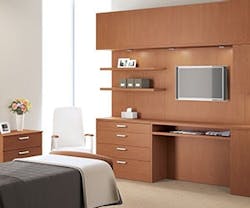In facilities management, it’s a jungle out there – but that doesn’t mean your site has to foster SARS. Utilize antimicrobial surfaces to inhibit or reduce the growth of unwanted microbes like bacteria, mold, and fungi.
But alone, the technology may not be enough to provide a safe site. Implement antimicrobial finishes in conjunction with basic design and maintenance principles in order to maximize their impact.
The Evolution of Adoption
They work several ways. A coating with a chemical compound that is toxic to microorganisms may be applied to surfaces. Polymers and polypeptides also serve this function. Recently, copper and its alloys were discovered to be natural antimicrobial materials with intrinsic properties that resist and destroy a wide range of germs.
As a design tool, antimicrobial technology has been around for decades, but it has been adopted slowly, says Dan Lee, national design manager at Business Interiors by Staples.
“The ancient Egyptians used copper to purify water, but the first modern antimicrobial agent was topical – it was something you sprayed on materials,” Lee explains. “Then the chemistry could be woven into textiles or applied to surfaces chemically. The most recent generation integrates precious metals that naturally retard and repel infection.” (For more on this development, see below.)
Antimicrobial Finish Protects Against Biofilm
Silver and copper are being utilized for their natural resistance
Keeping your facility free from infection is valuable – and so are the materials that do so. Researchers at Germany’s Leibniz Institute for New Materials have produced abrasion-resistant antimicrobial coatings that incorporate silver and copper.
The colloids of these precious metals gradually release germicidal metal ions into the environment.
“They are only a few nanometers in size, but their particular ratio of size to surface area produces a distinctive long-term effect,” explains Carsten Becker-Willinger, head of the nanotechnology division at the institute.
The surface of the coating is also anti-adhesive, so neither dead nor living germs can adhere to the surface. As a result, the coating primarily counteracts the formation of an extensive biofilm.
The new material can be applied to a variety of substrates such as plastic, ceramic, or metal and cures thermally or photochemically. This allows antimicrobial properties to be included in HVAC systems, food preparation surfaces, and fixtures.
Antimicrobial finishes are being implemented from floor to ceiling, on everything such as walls, counters, and furnishings.
“They are even utilized in HVAC systems and standard wall insulation,” adds Jeremy Dayton, vice president of Polymer Technologies. “Almost every component can be protected against germs.”
Early adopters of the technology are offering occupants improved quality of life, a potential selling point for future tenants, Dayton says. By 2018, antimicrobial coatings are expected to become a standard requirement in high traffic buildings, such as offices, hospitals, and schools, according to a forecast by research firm MarketsandMarkets.
The Importance of Upkeep
People and layout can have as significant an impact as antimicrobial finishes. It’s up to you to put cleaning accessories in proper areas and even educate the general public on the importance of washing hands.
“Think about checkpoints and spaces where people can be reminded of cleanliness. Have hand sanitizers in appropriate locations. Make sure the door swings without having to turn a knob. If a sink leaves the physician or caregiver’s back to the patient, they’re less likely to use it,” explains Lee. “We’re busy – we make mistakes. Above and beyond, take a holistic view.”
Although antimicrobial finishes mean areas won’t have to be cleaned as often, Dayton notes, proper maintenance has a significant influence on performance.
“Create a document that compiles all the finishes and material in your facility. Include the cleaning guidelines based on each,” advises Lee. “One method doesn’t fit all.”
Air, sunlight, and unfriendly cleaning solutions can degrade the antimicrobial coating faster than general wear and tear. If your staff is subject to periodic turnover, it’s important to constantly train them on different care methods.
Beware that simple cleaning is distinct from sanitation and disinfecting. “Bleach is what people tend to turn to in healthcare, but it can be very potent and must be used in proper ratios,” explains Lee.
This germ-killing technology may allow you to save money by reducing the maintenance costs associated with cleaning or replacing unsanitary objects, says Dayton. But the cost of not utilizing this technology may be just as motivating.
“In healthcare, there is a law that if a patient acquires an illness while hospitalized, then Medicare or Medicaid doesn’t cover the bill,” Lee explains. “If you have an environment in which infection can spread, it can hurt your business’s financial performance.”
